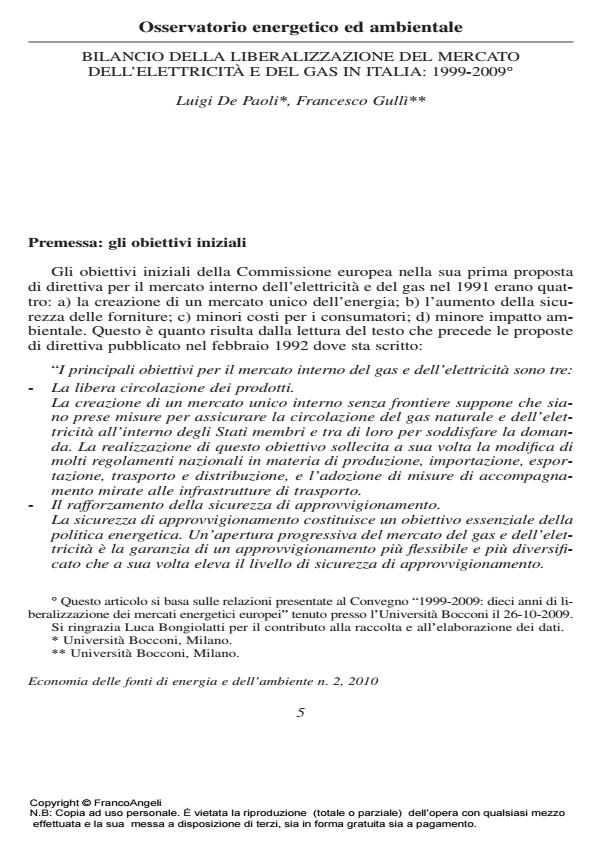An evaluation after 10 years of power and gas market liberalization in Italy (1999- 2009)
Journal title ECONOMIA DELLE FONTI DI ENERGIA E DELL’AMBIENTE
Author/s Luigi De Paoli, Francesco Gullì
Publishing Year 2011 Issue 2010/2
Language Italian Pages 34 P. 5-38 File size 2133 KB
DOI 10.3280/EFE2010-002001
DOI is like a bar code for intellectual property: to have more infomation
click here
Below, you can see the article first page
If you want to buy this article in PDF format, you can do it, following the instructions to buy download credits

FrancoAngeli is member of Publishers International Linking Association, Inc (PILA), a not-for-profit association which run the CrossRef service enabling links to and from online scholarly content.
Ten years after the liberalization of the electricity and gas market in Italy it is possible to draw an evaluation of the achievements. The three key objectives of the single market mentioned in the original proposal of the European Commission have been achieved differently in the power market and in the gas sector. The exchanges with foreign countries has increased in the gas sector, but not in the electricity. The security of supply in both sectors has grown thanks to the investments. The price for final consumers has two parts: the competitive and the regulated one. The industrial component has only marginally decreased. Instead the costs for network utilization diminished more sensibly due to regulator intervention. The convergence of Italian prices compared to those in Europe was more modest in the electricity than in the gas sector. The industrial structure in both sectors has changed a lot. Much more players are operating now and the degree of concentration in all segments fell. This announces an increase in competition. Finally, there was a significant international opening both because some Italian companies have made significant investments abroad and because many foreign companies, especially European, are now present in the Italian energy market.
A dieci anni di distanza dalla liberalizzazione del mercato elettrico e del gas attuata in Italia dai Decreti Bersani (1999) e Letta (2000) è possibile fare un bilancio dei risultati ottenuti. I tre obiettivi fondamentali del mercato unico dell’energia indicati nella proposta originale della Commissione europea sono stati conseguiti in modo diverso nel settore elettrico e del gas. L’interscambio con l’estero è aumentato nel settore del gas, ma non in quello elettrico. La sicurezza di fornitura è cresciuta in entrambi i settori grazie agli investimenti effettuati. La diminuzione dei prezzi per i consumatori finali è stata modesta per la componente industriale, mentre è diminuito il costo per l’uso delle reti grazie all’intervento del regolatore. La convergenza dei prezzi italiani rispetto a quelli europei è stata modesta nel settore elettrico e maggiore nel settore del gas. La struttura industriale in entrambi i settori è cambiata molto. È aumentato il grado di pluralismo dell’industria ed è diminuito il grado di concentrazione in tutti i segmenti lasciando presagire un aumento della concorrenza. Infine vi è stata una notevole apertura internazionale sia perchè alcune imprese italiane hanno effettuato importanti investimenti all’estero sia perchè molte imprese straniere, soprattutto europee, sono adesso presenti nel mercato energetico italiano.
Keywords: Liberalization, energy policy, power industry, gas industry, regulation, prices, industrial structure
Jel codes: D40, D78, K23, L11, L22, L94
Luigi De Paoli, Francesco Gullì, Bilancio della liberalizzazione del mercato dell'elettricità e del gas in Italia: 1999-2009 in "ECONOMIA DELLE FONTI DI ENERGIA E DELL’AMBIENTE" 2/2010, pp 5-38, DOI: 10.3280/EFE2010-002001